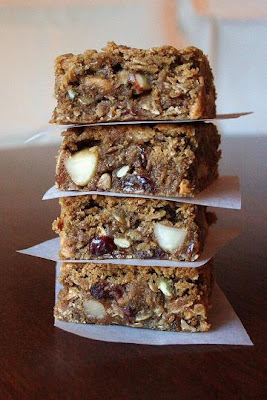 When, like me, you cook a lot, not everything falls into the 'spectacular success' category of recipes that you know you'll be making over and over again. Quite the opposite really, which is why it's pretty exciting when I do come across those rare combinations of ingredients and technique that demand instant addition to the never-to-be-lost-scraps-of-paper collection which regularly gets shuffled between my desk, kitchen, and lounge room table (and sometimes gets lost...if I can find the fresh pea felafel recipe I made a few months ago out of a magazine published around the same time, but that I can't for the life of me remember the title of or where I put it, I will actually skip to the kitchen to make it again, and you will all be hearing about it).
When, like me, you cook a lot, not everything falls into the 'spectacular success' category of recipes that you know you'll be making over and over again. Quite the opposite really, which is why it's pretty exciting when I do come across those rare combinations of ingredients and technique that demand instant addition to the never-to-be-lost-scraps-of-paper collection which regularly gets shuffled between my desk, kitchen, and lounge room table (and sometimes gets lost...if I can find the fresh pea felafel recipe I made a few months ago out of a magazine published around the same time, but that I can't for the life of me remember the title of or where I put it, I will actually skip to the kitchen to make it again, and you will all be hearing about it).Today's recipe was not destined to be of the spectacular variety, but it certainly wasn't bad and with a bit of work might even make it a little further up the ranks, so I thought I would share it anyway. It's another contender marked off the list in my endless quest for the perfect muesli slice, and although it doesn't fit my picky criteria on account of being a bit too cakey, I did quite like it in a fudgy, squishy, oaty kind of way. The one thing I would definitely keep in mind if I make it again (and I may) would be to reduce the sugar as it was quite sweet. I used my own Toasted Nut Crunch Muesli (which I would certainly encourage you to make, and not only for purposes of this recipe!) which does have brown sugar in it already, so I guess if you wanted to use an untoasted/unsweetened muesli perhaps you could get away with using the full amount of sugar.
The bare bones of the oat cake base for this come from a recipe out of Jo Seagar's The Cook School Recipes, for White Chocolate Caramel Oat Cake (obviously minus the white chocolate and caramel - God knows what possessed me to set to work with the least appealing-sounding food of the three on that list, given the choice!). I picked up Jo's book in New Zealand last year, and while I'd suggest she's probably not that well known to the rest of the world, she is known throughout New Zealand, and reasonably well in Australia, for her cookery school Seagars and her down-to-earth approach to delicious country-style food. I have long been an admirer and am really enjoying cooking from the book - particularly the sweet options, which are the sort of things your Nanna might make if she were a hip, modern Nanna (like mine, I am lucky to say).
Back to the cake, though. It's ridiculously easy - you just throw everything in a bowl, stir it around until it's mixed, squash it into a tin and you're away! And let's face it, if it's not the absolute best recipe you've ever made, it'll be far from the worst, full of faux-goodness from the muesli, and give you something to work towards for the next time you make it. They can't all be winners, can they?
Muesli Slice
makes 16 large-ish squares, or more if you decide to cut them smaller
1 and 1/2 cups wholemeal plain flour
3/4 cup white plain flour
1 tsp baking powder
1/2 tsp bicarbonate soda (baking soda)
2 and 1/4 cups toasted muesli
As mentioned above, I used my homemade muesli for this, although you could use whatever you like, even untoasted if you are prepared for the end result to be a bit less nutty and toasty tasting. The one thing I would advise is that if your muesli doesn't contain much fruit or nuts, add some extra into it or your slice will be pretty boring.
1/3 cup dessicated coconut
1 and 1/4 cups dark brown sugar
I would definitely reduce this to a cup, or maybe even 3/4 cup to make things less sweet, unless your muesli is unsweetened or you have a real sweet tooth.
2 large (59g) eggs, lightly beaten
250g unsalted butter, melted
Preheat oven to 180C. Grease and line a 20cm square cake tin or baking tray (I like to line up the sides of the tin to make it easier to get the slice out after baking).
Put all your ingredients into a large mixing bowl and mix thoroughly until combined. Pour the mix into your tin and smooth the surface.
Bake for 30-40 minutes, or until the slice is just cooked in the centre and a skewer tests clean. Don't overbake it - a dry, firm slice is not what you're aiming for here, more like a soft-ish cake. Allow to cool in the tin before cutting into slices or squares (I put the whole thing in the fridge overnight, which made it much easier and cleaner to cut).


